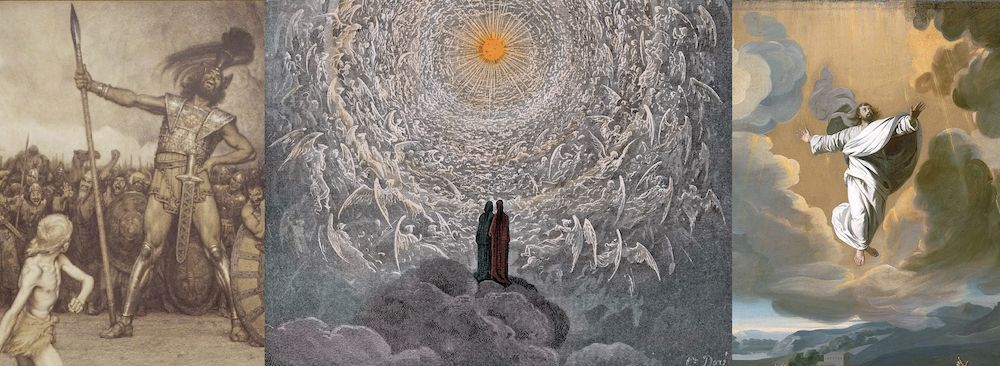
Heroes on the Path of Love
The experience of the reality of love is incommunicable. The experience of love cannot be conveyed. It cannot be written out in a poem, song, painting, equation, or in a dictionary. It is something that can only be known through the experience of it.
Before studying this lecture, you should evoke in meditation an experience where you have known what real love is, at least the taste of it. We access that quality most directly when we are helping someone who is in need. The reality of love is most known through compassion, service, aiding someone who is in pain, protecting someone in danger, comforting someone who is afflicted with suffering. In those moments we are not seeking anything for ourselves but seeking only to help. In those moments when we serve someone who is suffering we forget our needs. The only thing in our perception is the need of the one who suffers. To know that experience is to know love, and the doorway to reality.
Meditate first and invoke some experience of your own of truly acting from love to help someone, and reflect on the quality that brings into you, because that is the seed of true liberation from suffering. The experience of that type of compassionate action indicates the seed within every living thing which can become something far beyond what we can imagine, what we’ve been taught, what we’ve symbolized in religion and spirituality, a living reality that is incommunicable but nevertheless incredibly real.
This lecture is called “Heroes of the Path of Love” and it follows the lecture we gave before, The Entire Path to Liberation, in which we very quickly gave an outline of the path to complete and total liberation from suffering. That path has not been openly taught to humanity in our entire history until the last fifty years or so.
It was always symbolized in every religion. Every religion and mythology present symbols and initial concepts of the path but none of them have ever explained it openly. They only gave us clues, hints, archetypes, blueprints, which if we were to succeed in entering the path would be exposed to us privately, secretly. So, having explained that in our precious lecture, today we are going to look practically at how to achieve it. It begins precisely in the quality we meditated on today: the quality of love, but a type of love that is extremely active and has certain characteristics that we can describe conceptually, but are best recognized through the experience of them. That is why again I emphasize the importance of meditating on our own experience.
In the previous lecture we discussed three mountains. These mountains represent stages of development, how the consciousness from our current state which is as an embryo or a seed can be nourished, grown, and freed from its conditioned state so that it ultimately can break free of its shell and grow into something spectacular. That process of development has many stages, and they are represented in a symbolic way by three mountains. If you have not studied that, I recommend that you go back and study that now.
The Absolute
On the Tree of Life, at the top we see a light that emerges out of the emptiness.

In every religion, particularly the oldest ones, it is said that creation emerges out of a profound emptiness or nothingness, a profound potential, which in the Hebrew language is called Ain, which means literally “nothing.” In Hinduism and Buddhism this is represented as the primordial Brahma, which is a nothingness or a potentiality.
In Buddhism in particularly, it is called Shunyata (“void/empty”), but it doesn’t mean that it is an absence of things but rather a potential of things. It is like a space that is abstract and it allows things to become. It is the basis of everything. Without understanding the arena within which the existence is cradled you cannot understand existence.
This is similar to the reality of our physical bodies. We believe that these physical bodies are exactly what they appear to be—solid, lasting, and reliable—but they are none of those things.
The physical body is incredibly impermanent. It is constantly changing. If you have the capability to see its reality, you would see that the vast majority of your body is empty space. Each atom is mostly empty space.
The physical body appears solid and lasting, but it is not. This is proven in physics and has been described in metaphysics for thousands and thousands of years, and yet we still don’t get it.
We are very hypnotized by our sensory perception. We feel that this physicality is concrete and real and reliable and lasting. Yet it is none of those things.
All of nature is like that. Nature is not how it appears to our senses. We only see a fraction of what is there.
The Tree of Life represents all of the levels of nature. The physical body is at the bottom, a very dense layer. Within our body are many levels of nature, most and more subtle, until you ascend all the way to the height where you return to that potential, that emptiness, within which is cradled existence. All of that is within us, but we are unaware of it.
There is a threshold, a boundary, where the unmanifested emerges into manifestation, where the potential becomes something, where from that emptiness emerges light. That light is what people call God. In different traditions it is symbolized in different ways. There is a very beautiful symbol of that light which most of us now of days are ignorant of, which in Greek is called Phanes.
Phanes (Φανης)
In the ancient Orphic mysteries from thousands of years ago the great mystics of that time represented the primordial beginningness of things as Phanes.
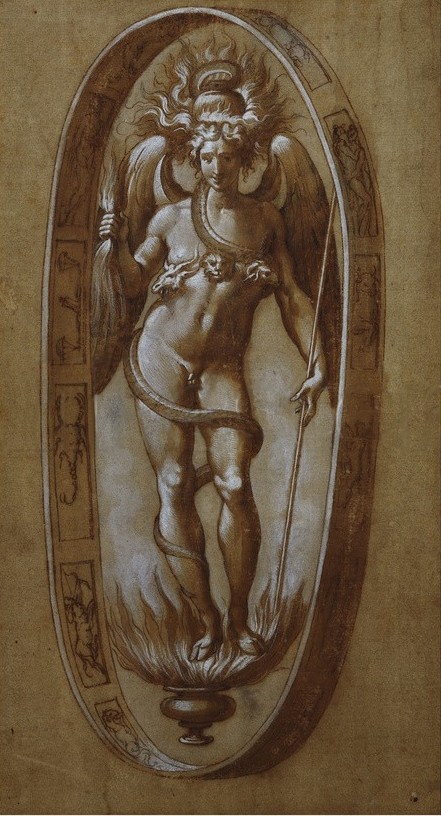
In Greek, Φανης Phanes means “to bring light, to shine.”
“I invoke Protogonus [first god], of a double nature, great, wandering through the ether,
Egg-born, rejoicing in thy golden wings,
Having the countenance of a bull, the procreator of the blessed gods and mortal men,
The renowned Light, the far-celebrated Ericepæus,
Ineffable, occult, impetuous, all-glittering strength;
Who scatterest the twilight clouds of darkness from the eyes,
And roamest throughout the world upon the flight of thy wings,
Who bringest forth the pure and brilliant light, wherefore I invoke thee as Phanes,
As Priapus the king, and as dazzling fountain of splendour.
Come, then, blessed being, full of wisdom and generation, come in joy
To thy sacred, ever-varying mystery. Be present with the Priests of thy rituals.” —Orphic fragment
Phanes was described as male/female. This is the same as the primodial Hindu divinities, and the Hebrew:
“In the beginning אלהים Elohim [literally “god-goddess”] created the heaven and the earth.” —Genesis 1:1
Phanes emerged out of a cosmic egg (the abstract absolute space) and had four heads: an eagle, a lion, a bull, and a man. The Christians adopted all of that symbolism as the four evangelist in the four gospels. It is also in the old testament in relation with the four holy creatures (Chaioth ha Kadosh) described in the book of Ezekiel.
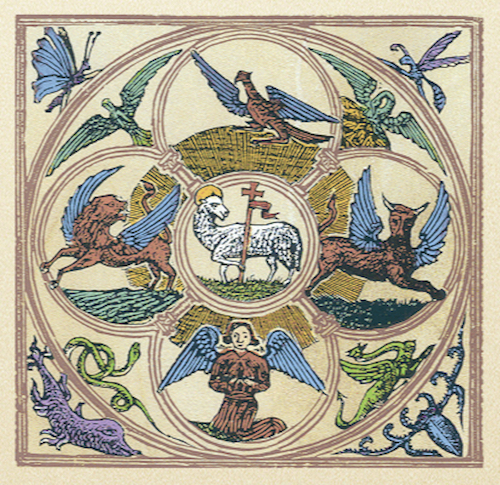
Phanes is the primordial divinity, the creator. It is seen as the manifestor the one who brings all things into being . All of the gods all of the human beings, all of creation emerges out of this light.
“I call upon thee, o living god, radiant with illuminating fire. O unseen parent of the sun! pour forth thy light giving power and energise thy divine spark. Enter into this flame and let it be agitated by the breaths of thy holy spirit. Manifest thy power and open for me the temple of almighty god which is within this fire! manifest thy light for my regeneration, and let the breadth, height, fullness and crown of the solar radiance appear, and may the god within shine forth…” —translated from a rescension of a Greek Papyrus by Dr. Carl Wessely, Griechische Zauberpapyrus, 1888
Here is where the problems always begin in all religions. We take these symbols and think they mean things that are outside of us, that are in space, or they were in the ancient past. That is not the meaning. This symbol of Phanes is inside of you. It is inside of me. It is that boundary between the void and what is. It is where the light emerges out of the emptiness into being something, that is Phanes.
Phanes is the light that comes out of the Absolute, which is represented at the very top of the tree of life, and in Hebrew is called Ain Soph Aur, which means the “limitless light.”
In Buddhism it is called Amitabha, which is the primordial buddha, and his name also means “limitless light.”
That light is not outside of us, it is inside of us.
That light is what eventually descends through the tree of life through the levels of nature to give us life. We don’t remember that and we don’t see that. We are not aware of it. The process of initiation and walking the three mountains is a process of becoming of one with that. You don’t get there by believing, by theorizing, you get there by changing. Your consciousness, the embryo, must grow and become capable of holding that light and then transmitting it.
If you think about it, that is what a buddha is, a prophet, a master, a god: they are transmitters of power, light, fire, solar energy, shakti, shekinah... these are names for that energy in different religions and traditions. That is our spiritual purpose: to become transmitters of that light.
After a little while in history, this symbol Phanes came to be known by another name: Eros.
Eros (ἔρως)
Amongst the most ancient traditions in the Greek mysteries, Eros was known as Phanes, a progenitor deity.
Eros literally means “love.” It can also mean “life force.” At that time, Eros represented the creative power of divinity.
Yet as you know, anytime humanity gets a hold of something, we degenerate it. We have done it with every religion in the world. The depiction of Eros gradually degenerated.
“... in order to understand the ancients properly we must distinguish three Erotes: viz. [1] the Eros of the ancient cosmogonies, [2] the Eros of the philosophers and mysteries, who bears great resemblance to the first, and [3] the Eros whom we meet with in the epigrammatic and erotic poets, whose witty and playful descriptions of the god, however, can scarcely be considered as a part of the ancient religious belief of the Greeks.” —Dictionary of Greek and Roman Biography and Mythology
The mysteries of Eros began with Phanes, as a mystical male/ female creature representing the light that emerges out of the Absolute. It then became known as Eros as a young man who caused of the feeling of love, of sexual love or the attraction between the sexes. Later that degenerated further into the cupid figures that we now think of as Eros, wi which are mischievous, very tricky, and dangerous. In modern times, Eros has now become entirely degenerated and seen only as sexual pleasure, lust, degeneration, and nothing more. No one sees anything divine in sexual energy anymore. Sex is only seen as a playground for pleasure and that’s all.
In its original conception, which is the closest to the reality, Eros represents the solar light of Phanes that descends through the tree of life and gives rise to everything that exists. That light eventually appears in your physical body as your hormones. The hormones in your endocrine system are carriers of the light of Phanes. They are pushing for action, but because of the condition of our mind we convert that action into the pursuit of pleasure and the causes of pain, because the pursuit of pleasure inevitably results in suffering. That is basic Buddhism, basic religion. The cause of suffering is desire. That is the first truth that the buddha taught. It is the basic ethic of every religion in the world.
Yet, Phanes, Eros, Christ, did not create suffering. Suffering only occurs when we go against the laws of nature.
Eros has levels. Eros / Phanes is the creative power of God in every level of nature. In the superior worlds, Eros, is the creative power of the gods to create worlds. They do not do that through lust, they do it by harnessing that divine power and utilizing it in a divine way, in a sacred way. That same energy in Sanskrit is prana or shakti. It is the active exponent of divinity and in Hindu tantra this is known as Shiva Shakti. Shiva is the hidden impulse that is behind but when that energy, that impulse needs to act is is using its active exponent which is shakti, feminine, the creative power of the divine mother. That is a sexual power. In the superior levels, sexual power is utterly pure, divine, without any blemish, no lust, no pride, no anger, no demonic qualities.
"While free love binds, it is slain by separation, because Eros is that which really unites.
"Love kindles love, as fire lights fire. However, from where does the first flame come? From within you it springs forth from beneath the dominance of sorrow... this you know.
"Then... Oh gods!... When the hidden fire emerges blazing, that which is within and that which is without become one, and all barriers fall away in ashes.
"Love begins with a glimmer of affection, is substantiated by the power of tenderness, and synthesized in adoration." —Samael Aun Weor, The Mystery of the Golden Blossom
The object or purpose of Eros is beauty. This is retained through all the forms that Eros has taken over time, but the meaning of it has changed.
Eros as Phanes, as the progenitor of all things, unfolds the karma of the worlds because of the necessity of that karma to be in motion, but the objective of that light is to radiate beauty.
There is no God who wants suffering. There is no tyrant God in heaven looking down on the suffering creatures and laughing, and enjoying the spectacle. That notion is an invention of demons. The truth is that the gods are embodiments of love, and in their acts of creation they seek to bring beauty into the world.
Beauty is the motivation of Eros, the light, Phanes.
These words have another word that is exactly equal to them, but is more known today: Christ. Eros/Phanes, is Christ. What does it say in the Christian gospels?
“Then spake Jesus again unto them, saying, I [Φανης] am the φῶς phos [light] of the kosmos: he that followeth me shall not walk in darkness, but shall have the φῶς phos [light] of life.” —John 8:12
Phanes / Eros / Christ is the force of love. What is the goal of Christ but to bring beauty, the beauty of the soul? The beauty of our greatest potential.
When you study the tree of life, this light of Christ is the upper aspects of the tree: it is the Ain Soph Aur that emerges from the absolute, and that Christ is also the top trinity – Chokmah, Kether, Binah. The three in one, the trinity which is Christ, Chrestos, is light.
When we as human beings come into being, it is for the purpose for that light to create beauty through us. That beauty is not physical. Physicality is an illusion that does not last. You may have physical beauty for a few years when you are young, but that is not of interest to God, to the divinity within you. The true beauty that is in us is the consciousness, but in us its undeveloped.
When consciousness becomes developed it is as Tiphereth which is exactly in the center of the tree of life; that Hebrew word Tiphereth literally means “beauty.” Tiphereth is the human soul, which is what Christ wants to develop in us.
In mythology and religion, Tiphereth is always represented by warriors, heroes.
Christ, Eros, is seeking to create heroes.
Heroes
The words ἔρως Eros and ἥρως Hero share the same root; there is only one change, and it is a single letter.
These Greek letters originally came from the Phoenician dialect, and the Phoenician dialect came from the semetic root which is Hebrew. The letters of these words have their origin in the Hebrew language.
The first letter of ἔρως Eros is ἔ, epsilon, the fifth letter of the Greek alphabet, which came from the Hebrew letter ה Hei which is the fifth letter of the Hebrew alphabet. That letter ה represents a womb.
The first letter of ἥρως Hero is η, Eta, which is derived from the Phoenician heth, which is the eighth Hebrew letter, ח Chet. ח Chet is the first letter of the hebrew word chai, life.
“I [Φανης] am the φῶς phos [light] of the kosmos: he that followeth me shall not walk in darkness, but shall have the φῶς phos [light] of ח life.” —John 8:12
From the womb ה emerges life ח. From Eros (Christ) emerges heroes.
Life results from sex in all levels of nature. You cannot have life without sex. You cannot have physical life without sex, you cannot have spiritual life without sex. But the sex is different. The way to create a physical body is one thing to the way to create a soul is another. Both are sexual, but they are different.
This word Hero (Eros in Greek) is intimately related with Latin vir (hero) and the Sanskrit word vir or vira, which means man, hero, warrior. The Sanskrit word is the root of the English word for man. In old English, to say man you would say “wer.” (That’s why we have words like werewolf, “man-wolf.”) Vir is the root of the words virile, virtue, virgin. All of these words are sexual. All derive from the word hero, which is derived from the word Eros. Thus, even in the etymology of the words we can see that heroism, virility, and virtue all come from Christ / Eros / Phanes.
“In him [Christ / Phanes / Eros] was ח life; and the ח life was the φῶς phos [light] of men.” —John 1:4
The force of love creates heroes, and one is a hero through virility, virtue, chastity: sexual purity. That is why when you study all the mythologies in the world, who makes the heroes? The gods. Who creates Theseus, Perseus, Odysseus all these great heroes in the Greek myths? The goddess! She is always the one who creates the hero. Who creates Jesus? His mother, through immaculate sexuality, something divine, pure.
"Whatever joy there is in this world
All comes from desiring others to be happy,
And whatever suffering there is in this world,
All comes from desiring myself to be happy.But what need is there to say much more?
The childish work for their own benefit,
The Buddhas work for the benefit of others.
Just look at the difference between them!" —Shantideva
A genuine hero does not work for themselves. Our modern culture worships “heroes” who are selfish and degenerated. Our role models and our most applauded citizens are extraordinary greedy people, vain and arrogant. Modern culture worships people who have wealth, physical beauty, power, fame. How did they get those things? How do they keep them? Most of them are professional liars, like politicians and celebrities. These people have a career based on their capability to fool you; they are rich because they are experts at making us believe in something that is not true. That is how they get rich and powerful. They are not heroes. They fascinate, hypnotize, beguile the senses, in order to acquire more fame, power, status.
A real hero works for the benefit of others; they sacrifice themselves to benefit others, and that is how genuine happiness is always created in the world.
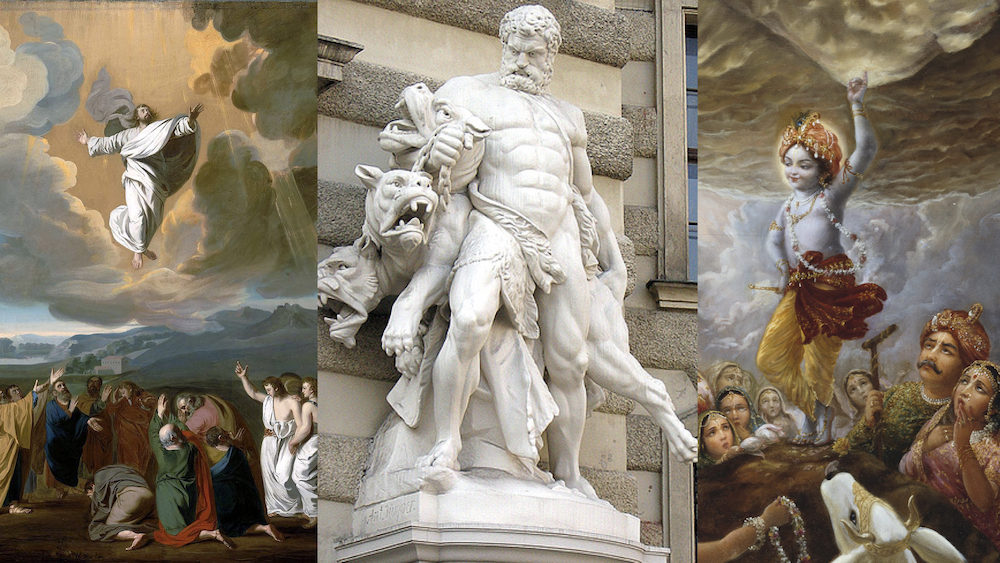
When we study the life of Jesus of Nazareth we see a true hero, a human being who in his every breath and word did nothing for himself. His every movement was to help others. When we study the life of Krishna we see enormous incredible feats of skill, courage, bravery and even humor. In everything he did and said it was never for himself but to help others. We find incredible similarities in their two life stories, because both of them were incarnations of Eros. Both of them were heroes in the fullest sense. They were human beings who rose out of the mud of the earth and became fit vessels, incarnations of that light of Phanes. They were transmitters of that light, capable of transmitting the wisdom of divinity through their every action.
They aren’t the only ones who did that. There are many, many examples of human beings that became incarnations of Eros / Christ / Vishnu. What about Herakles, Samson, Joan of Arc... In all these examples we see, whether in the symbolic form or literal form, how all of their actions, huge enormous incredible feats of superhuman ability were performed to help others, to conquer the causes of suffering and bring light to the world.
You know the most extraordinary thing? Every human being in the world has the capacity to become just like them. We are simply embryos of this type of hero. The light that they transmitted through their actions is within us as well, but in us it is not yet blossoming. It cannot because our inner conditions need to change in order for that to happen. We have the potential if we choose to act and change.
How to Create a Hero
In every story, we see that for them to become heroes they needed a mother.
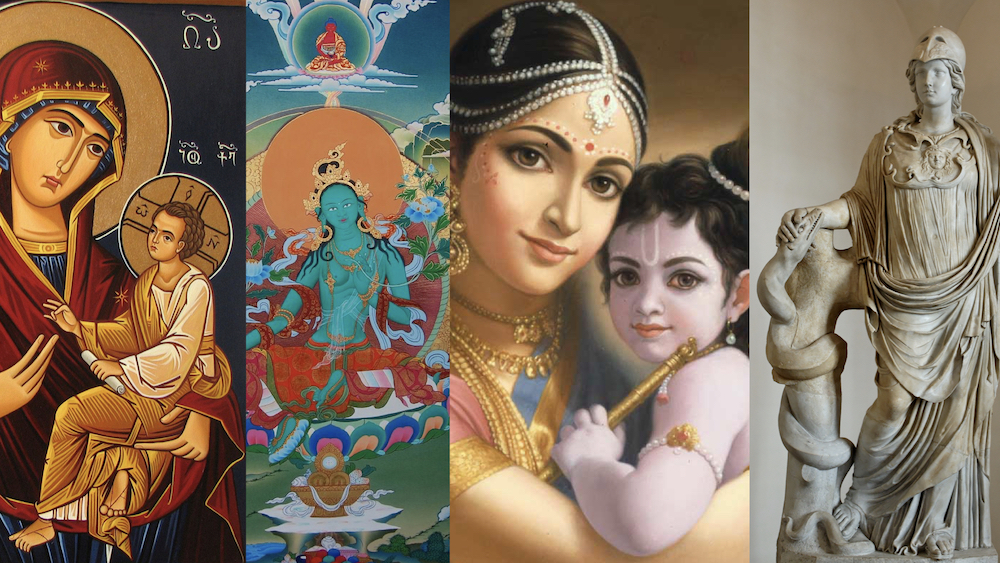
Athena created the heroes amongst the Greeks; she gave them their armaments, crafted for them all of the elements they would need in order to face the terrors they had to overcome.
Here we see Green Tara from Buddhism, the embodiment of compassion; out of her love for all existing things emerge all the great heroes who bring relief to those in pain.
All these feminine forces are symbolic. They represent the divine feminine that resides within every one of us.
Our divine mother is inside of us waiting for the moment to give birth to that Christic force in us. That Christ child is born in the manger amongst the animals of our egos.
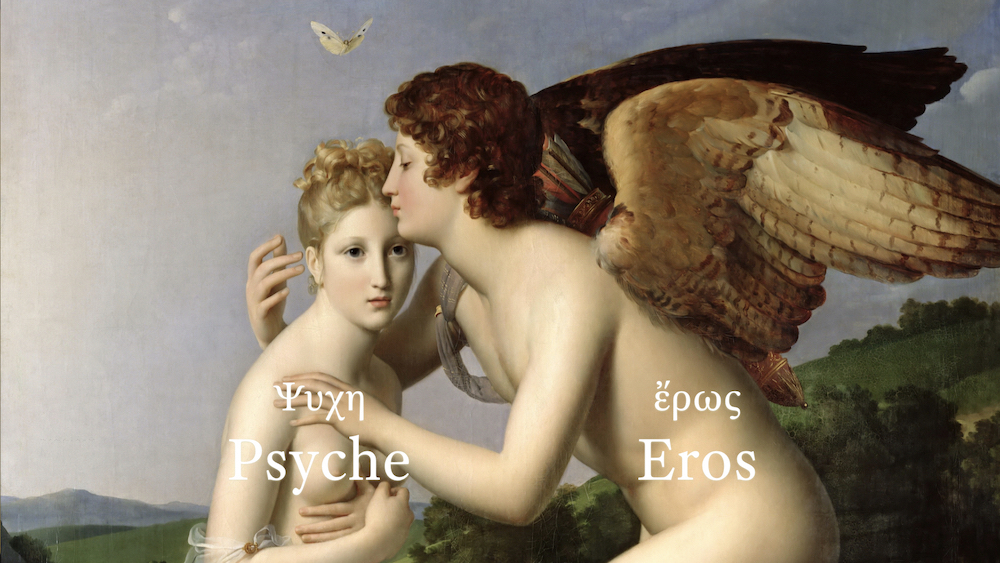
That story, that cosmic drama, is symbolized amongst the Greeks through the story of Eros and Psyche. This story has been hugely degenerated in the modern era, grossly misunderstood. In synthesis, the story tells how Eros, the force of love, guides our soul, which is psyche. This myth came from the old initiatic traditions, the mystery schools of the Greeks. The real meaning of those mysteries was never given publicly. All of the interpretations since the Greek era are all guesses, because the ones who gave that myth of Eros and Psyche never gave the meaning. Nowadays of course all the scholars and philosophers think they know exactly what Eros and Psyche means, but they are all wrong. For us and our purpose, for what we need to understand is simply this: Eros represents Christ. Psyche represents our soul.
The word psyche literally means “soul” and “breath” at the same time. It is directly correlated with the words Neshamah, Ruach, and Nephesh in Hebrew, each of which mean soul and breath.
“And the Jehovah Elohim formed man of the dust of the ground, and breathed into his nostrils the breath of life; and man became a living soul.” —Genesis 2:7
Divinity, Eros, delivers the breath of life. We are psyche / nephesh, a simple soul, undeveloped. We want to become Nephesh Chaiah which is a soul that has Eros / Christ fully expressed. To have Nephesh Chaiah means the union of the soul with Christ: the union of Psyche and Eros. Such a person is awakened; they are a true hero. In Greek, the word hero also means “demi-god,” meaning someone who is a mixture of human and divine. A Nephesh Chaiah is a human being, not out of Eden, but back in Eden. They are awakened not just physically but internally; that is a soul that is developed. That is a hero or someone who can become a hero.
We are a Nephesh, Psyche, a soul that is undeveloped. That is why in the Greek mystery Psyche is asleep. That symbol is where we get our modern myths like sleeping beauty, Snow White, all these stories of the feminine character who is asleep and that needs to be awakened by a hero, a prince, who comes to awaken her with a kiss. That comes from Eros and Psyche. That prince represents Christ.
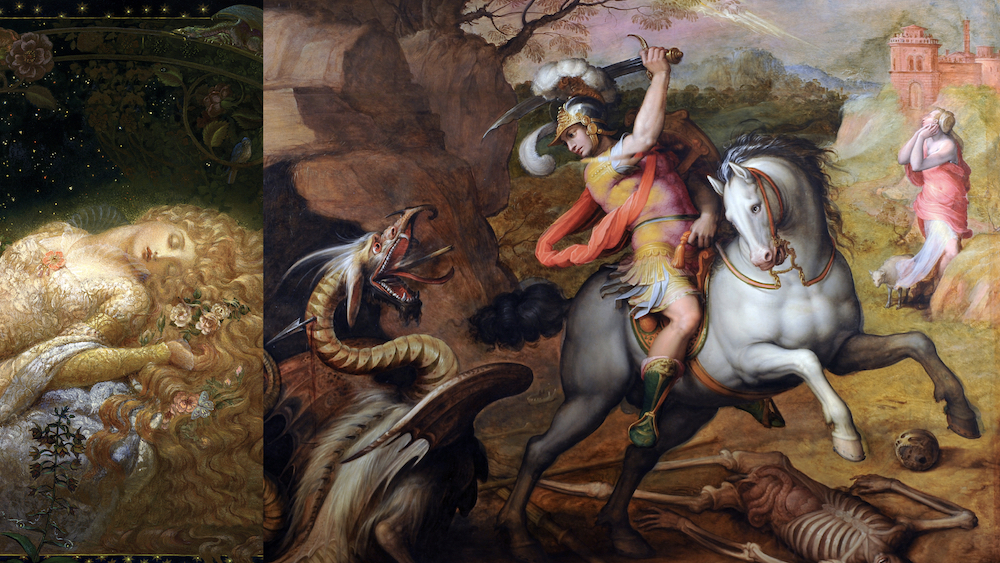
In our current condition, we are at the bottom of the Tree of Life. We do not have any development yet. It is through work that we can achieve something and grow.
Psyche/Nephesh/soul is something you can experience right now, since it is your consciousness. If you want to know how developed your soul is, then study how developed your consciousness is. How awake is your consciousness? Are you really awake physically? If you are awake physically you never forget anything. You can say “What was I doing thirty days ago at three o’clock?” If you are awake you will remember. We are not awake; we are asleep and dreaming that we are awake.
“People live dreaming, they work dreaming, yet nevertheless they mistakenly believe that they are awakened. During the normal sleep of the physical body, the ego is enwrapped in the body of desires and wanders in the molecular region like a somnambulist, dreaming, and when it returns into the physical body, when it returns to the “vigil” state, its dreams continue within the individual. The one who awakens his consciousness no longer dreams; he lives awakened in the internal worlds while the physical body is asleep.” —Samael Aun Weor, Light from Darkness
Our psyche is sleeping, dreaming. That is why in our teachings we begin awakening consciousness here and now, learning to meditate, learning to self-observe, learning to conserve energy. When we conserve energy, it can be used to strengthen consciousness so that it is better equipped to self observe, to meditate. Subsequently from that effort, we begin to awaken in the internal worlds, in our dreams. When your consciousness is awake, you do not dream, you are awake. Whether in the body or out of the body. You have to train to reach that level, you have to work with consciousness a lot.
The essential process is to take that sleeping psyche and awaken it. Later, you can convert it into a hero.
What does a hero do? The hero fights against the dragon. The dragon isn’t literal. The dragon represents your mind. The dragon is your pride, envy, lust.
This symbol from the chivalric times, the romantic era, shows the knight (Tiphereth) fighting the dragon- Shaitan, “the adversary,” the devil which is on the tree of life in the infernal worlds. The hero protects the maiden, which is Geburah, which is the divine soul. That is the conscious work to slay the dragon, to kill the minotaur, the hydra, the animal, the beast, the devil, the dragon… all of that is to kill the ego, the I, the collection of defects we mistakenly call “ourselves.” The job of the hero is to completely eliminate all of discursive and destructive causes of suffering inside our subconsciousness. We call them envy, jealous, pride, anger, lust, avarice, and laziness. Those many names symbolize the legions of devils within our own subconsciousness, all of which we created. God didn’t make those things, we did.
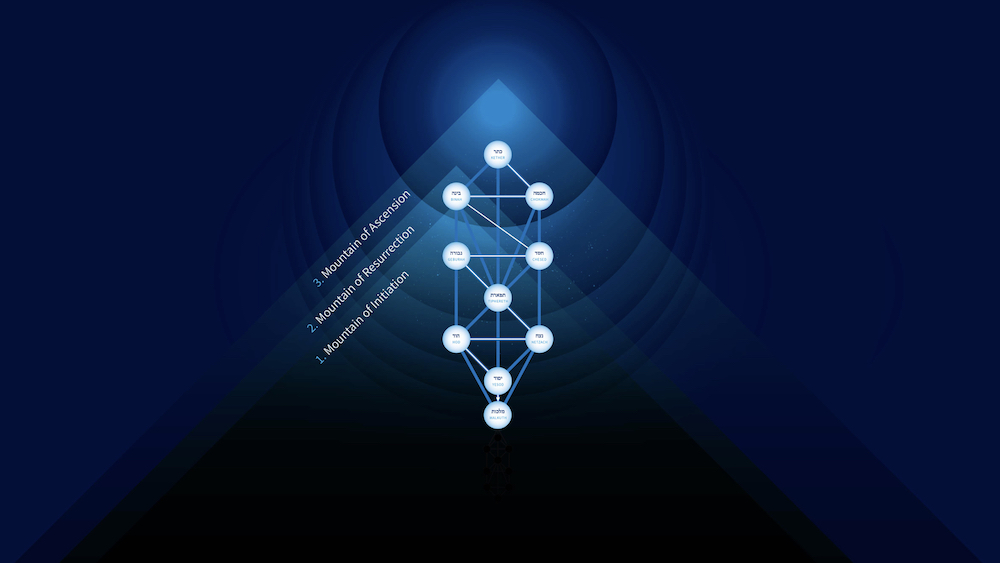
The work of a genuine hero is to conquer oneself. That is the basis of the three mountains. To conquer the three mountains is to conquer oneself. To complete the second mountain is to have the ego completely dead. This mean one has no karma, zero. One is a god. To complete the second mountain means that one is awake physically, in the fourth dimension, in the fifth dimension, in the sixth dimension , and at the verge of seventh: awake and able to traverse those levels at will, anytime.
That is an extraordinary rare person. They are out there, they do exist. But they are almost always anonymous, hidden.
The only way to reach that level is to become a hero, and the only way to do that is to incarnate the force of Eros. The only way to do that is to utilize Eros, sex, in a very smart way. That’s why we find in every religions in the world sexual mysteries, sexual symbols, sexual truths. Unfortunately, humanity has never understood them.
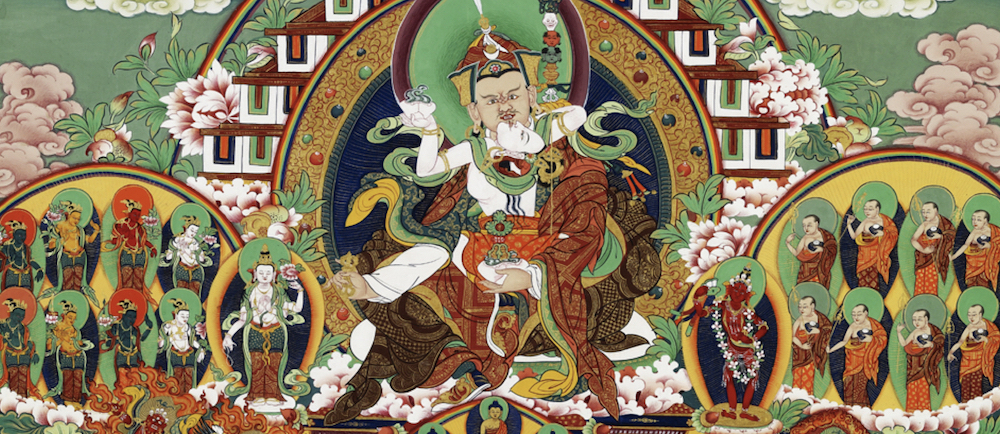
This symbol is from Tibetan Buddhism; it depicts Padmasambhava. Padmasambhava was an Indian tantric master who brought tantra from India to Tibet many centuries ago. He transformed Tibet into something completely different. He tamed all the black magicians in Tibet and converted them to Buddhism. He didn’t do that by humiliating them, or killing them, he did that by showing them the power of love. He did that through compassion and through his brilliant wisdom. Padmasambhava is what we call a “bodhisattva.” He is an incredible initiate, an incantation of Christ / Eros. This image is showing how to do the work. You see him in sexual union with his consort Yeshe Tsogyal. He told her in his instructions to her:
“Lustful people do not enter into the path of liberation.”
Our modern mind looks at this and sees a contradiction: “How can he be in the sexual act and say lustful people do not enter the path of liberation?” The answer is simple. They performed the sexual act without lust. For them sex was ceremonial, prayerful, a holy sacrifice. An act of love, pure. That is the mystery of Tanta as it was known in Asia. When that teaching was brought to the west, it arrived under a beautiful disguise: what we know these days as Alchemy. Alchemy is nothing more than tantra undercover. That was done to protect the teachings and to protect the foolish from messing with powers that would harm them, because as you know, knowledge gives power, and with power one can cause harm. To do this work, one must be prepared. To perform this work, one must be ready, because it is difficult. Without training, you will fail. That is why traditionally these teachings were withheld from the public and only offered at the secret level of instruction. It was only given in a symbolic form in every religion of the world, and it is present in every religion in the world, even in Christianity. The first miracle of Jesus is at a wedding. There’s a reason for that.
Through the work of harnessing the sexual energy one is harnessing the force of Eros, one is preserving within the body Eros / “life- force” / Christ.
The sexual energy is the creative power of God. That is why in every religion in the world among the first ethical rules that beginners are given are to not abuse the sexual energy, do not commit sexual misconduct, do not commit adultery, do not fornicate.
All of those rules were given to teach people to respect the sexual energy and to renounce animal lust, and to start seeing that sex has the potential utterly transformative, utterly beautiful.
The natural quality of sex is something holy. In the erotic atmosphere is the creative power of divinity. Humanity uses it to create babies. That is easy; every animal does that, there is nothing to it, but a couple who is educated in these mysteries can use that same power to create the soul. To create not in the flesh but in the spirit. That’s what is represented in these mysteries.
That is how one creates the soul and works through the first mountain.
When someone has reached the fifth initiation of major mysteries (which we explained in the previous lecture) they have created the soul: the astral, mental and casual bodies. They are awake to some degree in the third, fourth, and fifth dimensions. They are a human being finally. At that point they reach the opportunity to make a choice to continue their development on the spiral path, which is slow and easy, which is what most people take, or to enter the straight path which is rapid and extremely difficult and very few take that path.
If they take the direct path, they then receive the initiation of Tiphereth, which is this sephiroth in the middle of the tree of life which means “beauty.” By taking the direct path, Eros / Christ is born in them and they become a bodhisattva. That Sanskrit word literally means “essence of wisdom.” Bodhi is Sanskrit for wisdom. Sattva has a lot of meanings, but it means the essence of something, the heart of something, the goodness, the purity.
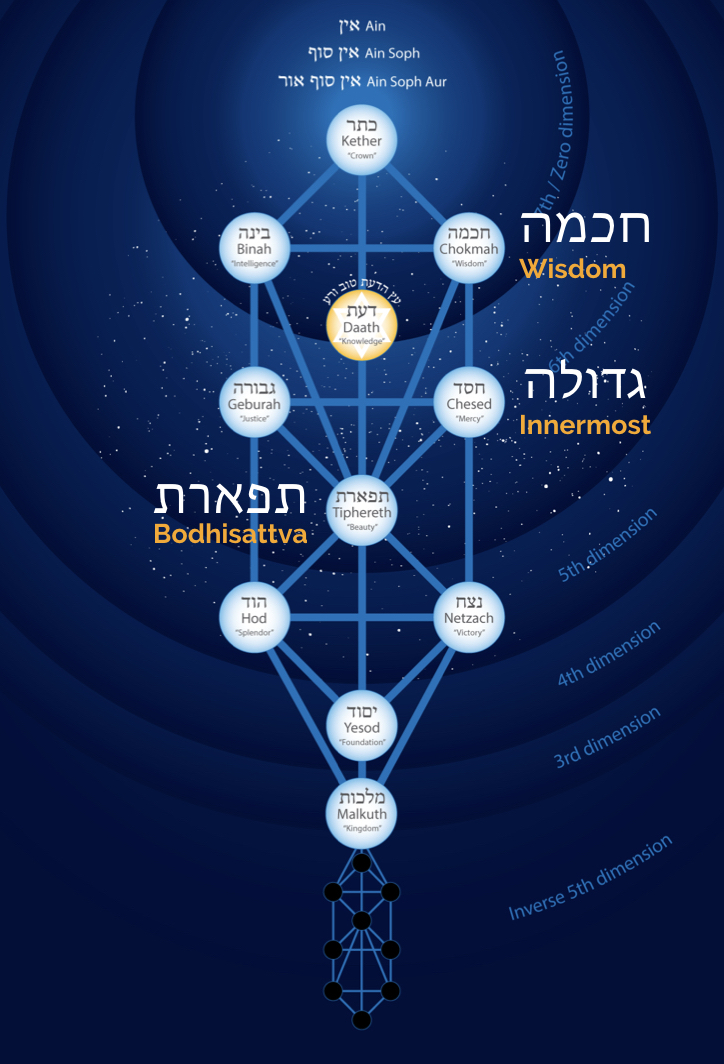
Bodhisattva is a title that is earned, and it applies to a person who is beginning a new stage of development. In Tibetan, the word for Bodhisattva is jangchup sempa. This is really interesting word in the Tibetan language, and it comes from Jang which means “the overcoming and elimination of all obstructive forces,” which obviously relates to all the myths we that know about the great heroes conquering the devil, dragon, minotaur, doing all the works of Heracles, descending into the infernal worlds, conquering the bull, the lion. They all represent the same struggle of the bodhisattva to conquer their own mind. The obstructive forces are not outside of us, they are inside of us.
What prevents us from being truly virtuous? Only our own defects. No one outside of us is preventing us from being virtuous.
Who is preventing you from being a chaste person and not having a lustful attitude? It is not anybody else: it is your own mind. It is your own lust that provokes lustful thought, lustful feeling, lustful impulse. It is not any other person.
Your mind is the obstructive force that must be conquered.
The real hero, the real bodhisattva, when they enter into the bodhisattva path, they are beginning that work to truly conquer themselves. That is what makes a real hero. It isn’t building temples or churches or having millions of followers. None of that is reliable or will last. Everything in the external world will pass away, but the qualities of your consciousness will not. You keep those even after death. So do not look for bodhisattvas in large spiritual groups, attracting attention to themselves, sitting before crowds spooning out quotes and jokes. The real bodhisattva only seeks to solve the problems of suffering, and for that they go where the suffering is greatest.
When we study this word bodhisattva we see that it means “essence of wisdom.” Wisdom is bodhi in Sanskrit, while in Hebrew it is Chokmah, which is Christ. It it Vishnu in Sanskrit, in the Hindu tradition, They are the same symbol. When someone becomes a bodhisattva they become an incarnation of that light. Eros/Christ is born in their heart, which is Tiphereth, beauty. That is why the goal and purpose of Eros is beauty. Eros / Christ does not look at physical beauty but the beauty in the human soul, because it is through us that Christ can work most effectively.
Consider that people say, “There is no God! I don’t see God! If I can’t see God then I don’t believe in God!” They are right in a certain way. If God is only in some abstract space that we cannot perceive, then how can God affect us, guide us, reach us? If we can’t see that level of nature, then we cannot confirm the reality of divinity. Yet, do you know how God can definitely reach you? Through another person, such as through someone’s actions, when someone acts on your behalf, cares for you with love. When you receive a profound, selfless, beautiful love, you can see God in that. That is what a bodhisattva does. A bodhisattva, by overcoming themselves, becomes the perfect reflection of divinity: love in action.
That is the beauty of divinity in action: through heroes on the path of love, selflessly serving those who are suffering, helping them see the light of divinity in action.
It is a long process to become a bodhisattva, especially to become a perfect bodhisattva.
To do that work, there are requirements that you need to understand.
- The main one we need to understand is this: you can only become a bodhisattva and enter that path if you have sufficient bodhichitta. Yes, this word sounds like bodhisattva, and they are related, but there is a distinction. We’ll talk more about bodhichitta in just a moment, but for now, understand that bodhichitta is a quality of consciousness.
- They also must also create the soul, which is the second birth described by Jesus in the bible. The soul is the chariot of Merkabah, the chariot of Krishna, the chariot of Apollo, all of which represent the solar bodies that allow the consciousness to be active in the internal worlds.
- Finally, they have to choose to enter into the direct path, which is done consciously in the causal world in the initiation of Tiphereth.
Those are the requirements to become a bodhisattva.
The one we really need to understand is bodhichitta. Let us examine this word. Bodhi is “wisdom.” Chitta’ means a lot of different things at one time: “mind, heart, aim,” are the main meanings we need to grasp. Chitta is your mind, your heart and your goal. So bodhichitta is to have a “mind, heart, and will” of wisdom.
The bodhisattva is formed in the atmosphere of the bodhichitta, and we can see that outcome in the word bodhichitta itself: bodhi represents the Christ / Avalokitesvara that incarnates in the bodhisattva, while chitta (mind, heart, aim or will) indicates the solar bodies that give it expression.
Bodhichitta is a psychological atmosphere. It is to have one’s entire psychological focus very concentrated in one direction. It is a quality of being, a quality of perception, a quality of cognition and understanding. It is a quality of consciousness.
Bodhichitta is rare. Few have it.
We do not develop bodhichitta through evolution. Bodhichitta is a conscious quality that must be created.
Bodhichitta is a kind of attitude, a way of being.
The quality of bodhichitta is present in every religion, but is presented in different ways philosophically. It is not always named Bodhichitta, and is often not even named specifically, but if you study religions and compare them you see that all religions were ultimately trying to convey bodhichitta even if they didn’t identify that as a specific quality.
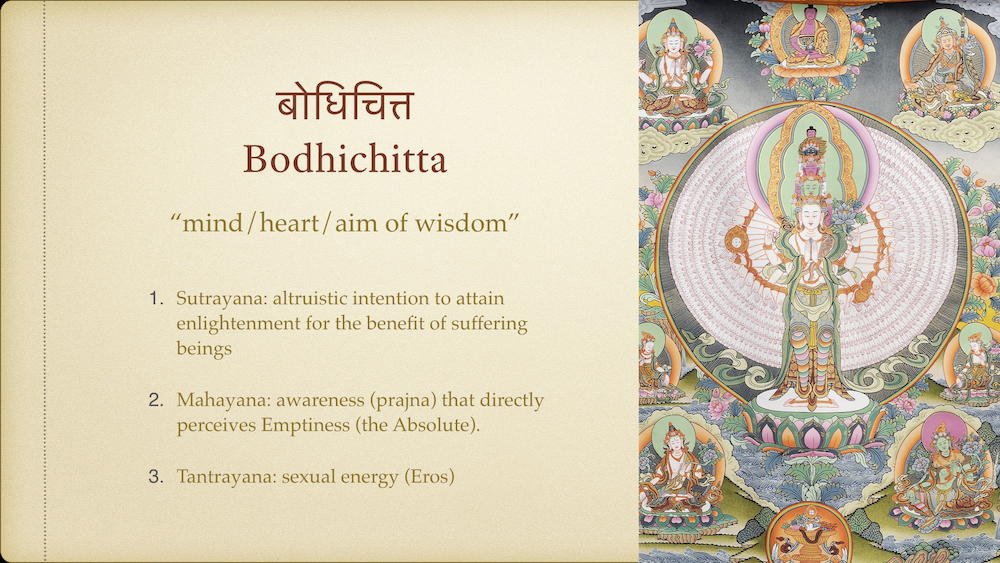
In the introductory levels of religion (such as the Sutrayana level of Buddhism) bodhichitta is seen as that altruistic intention to attain enlightenment for the benefit of suffering beings. That is how most people understand bodhichitta. They think, “I feel so much compassion for suffering creatures that I want to help them.” We can say that this intention is the seed that begins the development of bodhichitta. It is altruism, compassion, but it is only the beginning of Bodhichitta.
You find altruism developing among people who dedicate themselves to charitable causes, who live with little because they give so much. That type of person generally has some quality of bodhichitta developing in them, but altruism alone is not sufficient to develop bodhichitta or to become a bodhisattva. Altruism is a beautiful quality, but on its own is not enough. For altruism to grow into bodhichitta, they need cognizance of where bodhichitta comes from. That is the second aspect of bodhichitta, which is taught in the Mahayana level of Buddhism which says that bodhichitta is awareness (prajna) that directly perceives Emptiness (the Absolute). The technical definition for that is prajna. That term corresponds to the tree of life as Binah, intelligence in Hebrew.
Prajna is a type of perception, an understanding that penetrates into the ultimate nature of things. If you have studied the other courses and lectures we have given, you know that prajna is the result of samadhi, which is the result of ethics. Those are the three trainings of Buddhism. The main thing to grasp today is that simple altruism is not enough to truly help people. You need to understand the reality of the situation. To really help others, you need to see reality. Prajna gives you that perception.
The only way to see reality is if you have the capability to see the reality in meditation first. Then, you learn to see outside of meditation. That perception is prajna which is the capability to see the light of the Absolute. Now this sounds really strange to a beginner who is first studying this material because it seems so exotic and weird and it doesn’t make sense. Why do you need to be compassionate? Why do you need to understand the Absolute? The answer is because you cannot understand the nature of suffering if you cannot understand the nature of true happiness. To understand true happiness, you have to understand the Absolute. That is where we came from, and that is where true happiness is found. Genuine happiness, joy, and contentment and all the best qualities of the human being are within us; they are found in the true nature of the consciousness, which is directly connected to the Absolute Abstract Space. So, to help those who are suffering here in the lower worlds, you have to understand their true nature which is the Absolute, Christ, Eros. That is why altruism alone is not enough. To want to help is good, but altruism cannot cut through the causes of suffering and split them open and fundamentally change the situation for yourself or anyone else. For that, you must understand the truth at the base of things. That is why we always study the Absolute and the tree of life.
Things here in the lower world are the way they are because of causes and conditions. All of that is symbolized in the Tree of Life, which has its roots in the Absolute. Our fundamental root, our ultimate true nature, is found in the Absolute: that is our true, inherent nature. That is where the consciousness comes from. Until you can understand the Absolute, which is reality, and perceive that directly, and experience that personally, you will never, ever understand the problem of suffering.
That is why the third level of training (Prajna) is important. Prajna is what deepens bodhichitta very powerfully.
Someone who has prajna, perception of the emptiness, the absolute, who sees and experiences it, has so much more compassion than the average person who has some altruism or is trying to serve others. Those who have experienced prajna, having perceived the truth, then have a great zeal and tremendous insight into the reality of things that amplifies their compassion hundred-fold, a thousand-fold. It is immeasurable.
The third level of understanding bodhichitta is what is taught in Tantryana, which is that bodhichitta is in the sexual energy, Eros.
All religions had these levels of training, but the higher parts were never taught openly or written in any book. You can find them represented symbolically in every religion.
In the modern era, the use of those levels has been discarded. We are in a new era now. Now it is necessary to study all three levels simultaneously, because the only way now in our current condition that we can genuinely and profoundly change is to apply them all at the same time. We no longer have the luxury of going to lifetime to lifetime gradually moving up through the levels of education, acquiring more and more development. That is a luxury that we don’t have anymore. The rate of change now in this planet has become so rapid, and changes are coming that are going to make it more difficult for everyone. So it is necessary, if you really want to change and apply yourself to comprehend the path of the bodhisattva, the path of the real hero, you need to understand these three trainings very well: ethics, samadhi, prajna.
The main point today is to understand that your sexual energy is your bodhichitta. Do you want proof? Study someone who fornicates a lot. You will find that they are extraordinarily selfish, cruel, and they don’t care about anybody. They only want to feed their desires. That is because they have habituated themselves to purging the body of the presence of Eros through their addiction to the degenerated polarity of Eros, which is lust. That is why the priest or priestess, or monk or nun who is taught to conserve their sexual energy with the force of Eros has tremendous compassion. They also have the capability to withstand great ordeals, tests and trials with an attitude of love, because that power of eros is within them: they are conserving the sexual energy, which is the presence of Eros / Christ, which is the basis of bodhichitta. So, this is very simple.
By conserving the sexual energy and transforming through upright sexuality, we develop very rapidly, genuine altruism and insight into reality which are the two aspects of bodhichitta.
We learn to work with all three meanings of bodhichitta at the same time, united. That creates a radically different quality of mind from modern society.
Let me make everything extremely clear for you. Observe this simple polarity on the tree of life.
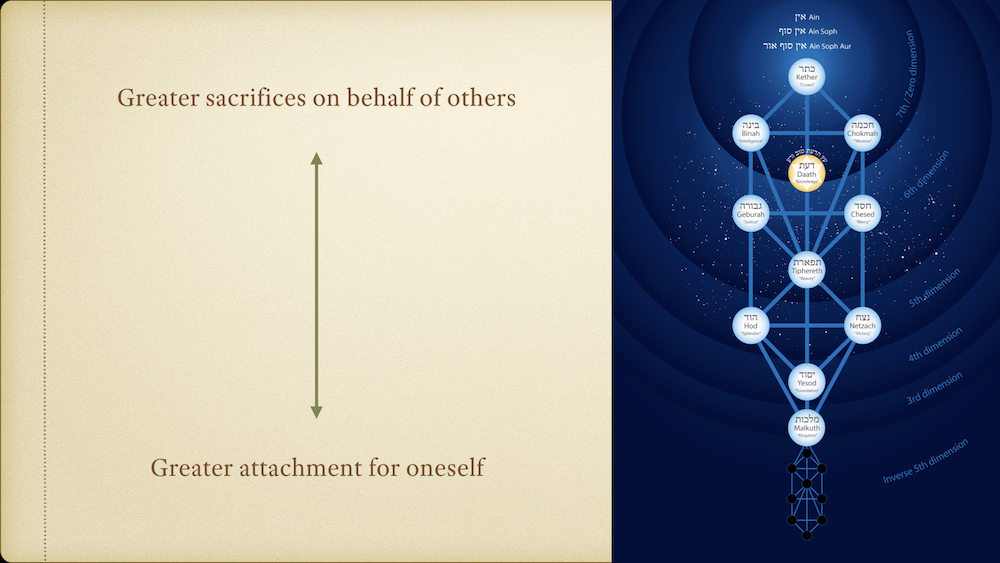
Greater sacrifices on behalf of others make you rise, greater attachments for oneself make you sink. Do you want proof of it? Go outside and observe society objectively. The more you clutch at attachments — the more you chase pleasure, the more you want — the more you suffer and the more suffering you create for others. This is what is taught in every religion in the world, there is nothing new to that. What we don’t realize is that it is our psychological attitude that guides our actions which in turn creates our happiness or our suffering.
“All happiness in the world comes from serving others, and all suffering in the world comes from serving myself”.
That is what the bodhisattva path is. One may become a bodhisattva by receiving the initiation of Tiphereth but that is only the beginning. To ascend that path means to perform greater and greater sacrifices on behalf of others.
The only way that you can do that is if you clear yourself of the obstacles that prevent it: to kill your pride, lust, anger, and to become empty like the Absolute.
Emptying yourself doesn’t mean lacking identity. That is what the ego thinks. The ego thinks, “If I kill all my egos I will become nothing!” Jesus is definitely not nothing. Padmasambhava is definitely not a nobody. John the Baptist, Joan of Arc, Moses, Milrepa, Marpa, Krishna... There is a long list of very profound human beings who purged themselves of all these defects and became something far more than “me, myself and I.” They became real heroes. That is the essence of how to do it: the overcoming and elimination of all obstructive forces.

All of those symbols represent the work we have to do on ourselves. The purpose of this discussion is to invite us to really discriminate who we are taking as our role models.
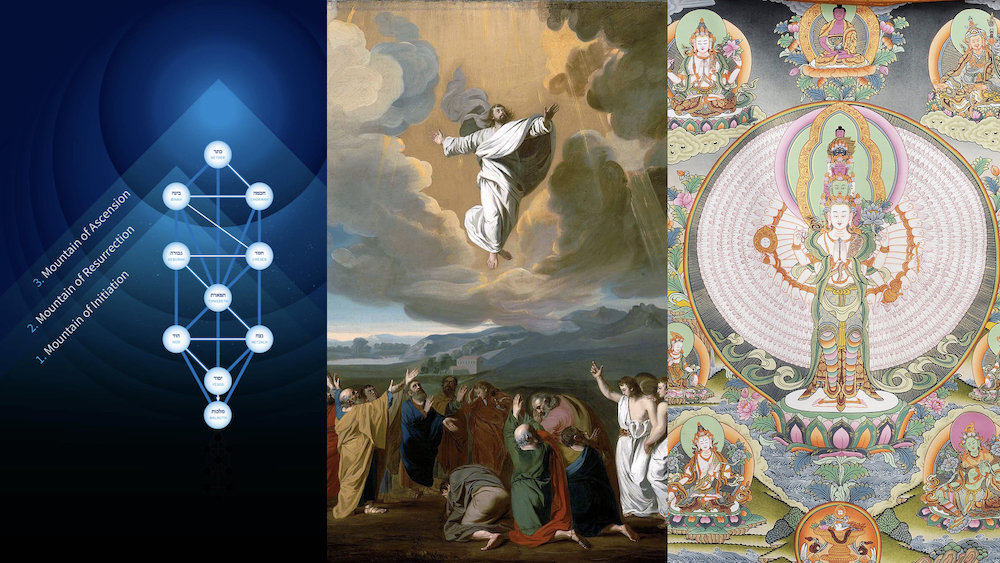
Avalokiteshvara represents Eros / Christ. At the very top of this image is Buddha Amitabha which means “limitless light,” and that represents the light of the Ain Soph Aur that comes out of the Absolute.
Avalokiteshvara, Christ, Eros, Phanes, Amitabha, all of these names are simply pointing out the tremendous power that is within your own consciousness. You simply need to appeal to it and become a vessel for it, but you cannot do that if you ignore it, and if you don’t understand how it works. You cannot do it if you are constantly fortifying your defects, worshipping idols in the physical world like celebrities or rock stars or whatever it is that people worship and try to imitate. Imitating the “modern heroes” is only going to bring suffering. You can dress like them, talk like them, and act like them but you are not going to be them.
Instead if you learn to study and learn to imitate Avalokiteshvara, Jesus, Buddha, Krishna, you can create profound changes. Firstly in yourself, because instead of strutting around like an arrogant celebrity or rockstar, you start to develop humility and compassion for others, you’ll have some restraint and cease creating suffering, and you’ll have some understanding. Little by little those will expand and grow. More and more insight, more and more understanding, less and less anger. More and more capacity to love.
Questions and Answers
Audience: I’m struggling to see the connection between the exercise of meditating on the emotion of love and the knowledge of emptiness. If we were to sit with that feeling would that allow some comprehension of emptiness?
Instructor: When the light emerges from the Absolute, it is one law, divine, perfect, and the best word we have to describe that is love. Thus, by meditating on what we experience as love, we can gain some comprehension. However, what we experience as love here is very far from the nature of the Absolute.
It is impossible to grasp the absolute with the intellect. But the intellect has a role here which is to accumulate information and have it on hand so that when the consciousness has an experience it has a reference that it can rely upon. That is why we study the full body of the doctrine. If you were to have skipped the study of the part that your intellect didn’t like or perceived as too difficult then you could have an experience and not have the tools available to understand that experience. That’s why we always insist on teaching you Hebrew, subtle symbols, abstract symbols...
You may not see why it is important, but if we are teaching it because you need to know it; you may not see it now, but you will if you meditate and keep practicing.
There is a lot to the teachings. Significantly, there are two fundamental trees: the tree of life, and the tree of knowledge, which is sexual alchemy. You have two understand both and study them together, always.
The only way you can understand the tree of life is to study the Absolute.
What is God? Love. That sounds simple, but it is not simple, because to understand that fundamental nature you have to go far past the physical body, the energy, the emotion, the thought, the will, the intuition, the spirit, and reach right up there to the trinity at the top of the tree of life, and even beyond that into the Absolute itself, because that is where that force of divinity emanates from.
To understand altruism is possible only if you understand where altruism comes from. If your altruism is coming from an ego, then you are going to cause more harm than good. The only way to know if your altruism is your ego or not is through experience.
For example, you cannot really know if you are in love with somebody until you experience what love is. It sounds like a contradiction, and maybe it is. You cannot know something until you experience it. Many people get fooled by passion, lust, enamorment, fascination. We see someone beautiful and we become fascinated by them and think we are in love, but we are not. It’s only when you actually experience what love is that you realize, “I was so fooled in the past! Now from my experience I know.” The same is true of everything else: altruism, love, real compassion.
It is one thing to be helpful and serve others and feel good about that and they say, “Thank you” and you feel good... that is nice, but that is not bodhichitta, nowhere near it. It is great to teach lectures or to donate to a charity or help this or that spiritual group, or to go to the soup kitchen and help the homeless. Great, wonderful, and it might make you feel warm hearted, but that is not bodhichitta.
Bodhichitta is there when you can see why that person is suffering, and understand the cause of that suffering, and see how to truly help them, and help that person selflessly in spite of their suffering. Even though they are lashing you with their tongue, cursing you, attacking you, still you serve them with love. In such circumstances, you are starting to taste what bodhichitta is. It’s a kind of love that manifests in spite of the obstacles. It is present even in the midst of terrific suffering.
Observe this beautiful example: Jesus being tortured, persecuted, spit on, mocked. In spite of all of that, he did not hate, did not become angry. Instead he prayed for his persecutors, because he understood them. That is bodhichitta. To understand that and to live that doesn’t come from beliefs or imitation, or a mere superficial understanding of things. We need a very deep understanding of things. That is why we need prajna, a kind of knowledge or insight that penetrates through illusions; we need discriminative wisdom. That is Binah.
Prajna is a quality of being that sees reality; it is in us. We can access that, we can experience that, but only if the consciousness is capable. That is why you have to meditate, and study the absolute.
To access prajna, you need meditation. To develop meditation, you need ethics. Those are the three trainings.
Part of the purpose of these studies is to learn to expand our understanding so that we can learn to see things in a new way and move past our old ways. All of this only has a function or value if we are expanding our capability to act. For example, in our meditation exercise today, we remembered the quality of love for someone, then imagined someone we do not feel love for. This naturally brings the question, “Why is it that I love that person, and why not this other person?” So then you shift attention and you imagine the person that don’t you feel that love for, to understand why. You might think you are doing this because you need to create love for this person, so you may think that you should try to evoke love for them, to try to force yourself to love them. That is not actually the purpose of the practice, because you cannot force yourself to love them. It doesn’t work. You can visualize this person and try to love them, but its not going to happen. Want to know why? Because you are not seeing why you do not love them. The obstacle is something in you, not in them. The purpose of this exercise is to see yourself, not the other person. What is the quality in you that is obscuring your capacity for love? That is the obstacle. The obstacle that must be overcome is inside of us. We do not love that person because of some quality in us. It’s not that they don’t deserve it. Sure they may have hurt us or done something painful to us, but that is in us. We only put value on that pain because of something in us. We have to understand what that is, is it our pride? it is it resentment? is it a prejudice? If you could then see that thing in yourself and work on that thing, and destroy that thing, then suddenly you would recognize that you do love them, and you know what? You love them more, because they are the ones that taught you what was wrong in you.
So part of what we learn in this path is to treat those who bring us discomfort as our teachers, not to reject them, or to blame them, or to criticize them, or to call them names, or talk bad about them but instead to realize “they are showing me something in myself that I don’t want to see. I need to look at that.”
In that observation and ability to comprehend that element in yourself, the study of tree if life is really critical. Our resentments and trauma and pains and our long list of people that wronged us is all misperception of reality. None of it is real. So if you have someone that treated you badly, in your mind you see them badly, and your anger is there, your pride is there and you see them as an enemy. That is how your mind perceives them, but it isn’t the truth. What we are perceiving of that person is what we are telling ourselves, but it is a decision, a choice; it is not the truth of them or truth of us, nor the truth of what happened. None of it is reality. Studying the tree of life and the philosophy of how things function can totally unlock that and show us the truth. The study of the tree of life is precisely to help us understand ourselves, and it is exactly to help us to understand our defects and how they cause suffering, and how they in turn cause others to suffer.
When we see other people suffering, instead of reacting with pride or anger we need to understand their suffering. We should love them, we should care for them.